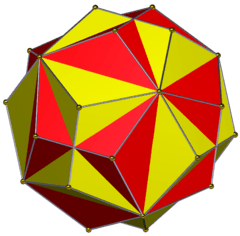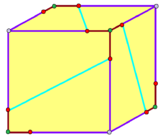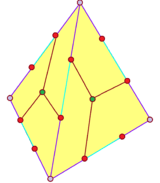Dodecahedron
| Ih, order 120 | |||
|---|---|---|---|
| Regular- | Small stellated- | Great- | Great stellated- |
 |
 |
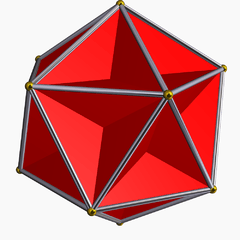 |
 |
| Th, order 24 | T, order 12 | Oh, order 48 | Td, order 24 |
| Pyritohedron | Tetartoid | Rhombic- | Trapezoidal- |
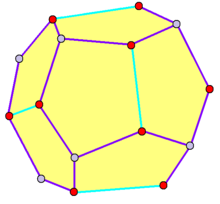 |
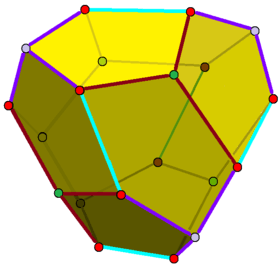 |
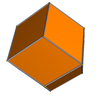 |
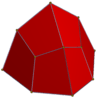 |
| D4h, order 16 | D3h, order 12 | ||
| Rhombo-hexagonal- | Rhombo-square- | Trapezo-rhombic- | Rhombo-triangular- |
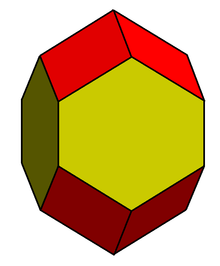 |
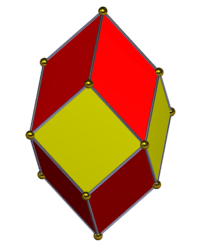 |
 |
 |
In geometry, a dodecahedron (Greek δωδεκάεδρον, from δώδεκα dōdeka "twelve" + ἕδρα hédra "base", "seat" or "face") is any polyhedron with twelve flat faces. The most familiar dodecahedron is the regular dodecahedron, which is a Platonic solid. There are also three regular star dodecahedra, which are constructed as stellations of the convex form. All of these have icosahedral symmetry, order 120.
The pyritohedron is an irregular pentagonal dodecahedron, having the same topology as the regular one but pyritohedral symmetry while the tetartoid has tetrahedral symmetry. The rhombic dodecahedron, seen as a limiting case of the pyritohedron has octahedral symmetry. The elongated dodecahedron and trapezo-rhombic dodecahedron variations, along with the rhombic dodecahedra are space-filling. There are a large number of other dodecahedra.
Pentagonal dodecahedron
The convex regular dodecahedron is one of the five regular Platonic solids and can be represented by its Schläfli symbol {5, 3}.
The dual polyhedron is the regular icosahedron {3, 5}, having five equilateral triangles around each vertex.
In crystallography, two important dodecahedra can occur as crystal forms in some symmetry classes of the cubic crystal system that are topologically equivalent to the regular dodecahedron but less symmetrical: the pyritohedron with pyritohedral symmetry, and the tetartoid with tetrahedral symmetry:
Pyritohedron
| Pyritohedron | |
|---|---|
 A pyritohedron has 30 edges, divided into two lengths: 24 and 6 in each group. | |
| Face polygon | irregular pentagon |
| Coxeter diagrams | |
| Faces | 12 |
| Edges | 30 (6 + 24) |
| Vertices | 20 (8 + 12) |
| Symmetry group | Th, [4,3+], (3*2), order 24 |
| Rotation group | T, [3,3]+, (332), order 12 |
| Dual polyhedron | Pseudoicosahedron |
| Properties | face transitive |
Net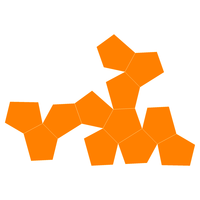 | |
A pyritohedron is a dodecahedron with pyritohedral (Th) symmetry. Like the regular dodecahedron, it has twelve identical pentagonal faces, with three meeting in each of the 20 vertices. However, the pentagons are not constrained to be regular, and the underlying atomic arrangement has no true fivefold symmetry axes. Its 30 edges are divided into two sets – containing 24 and 6 edges of the same length. The only axes of rotational symmetry are three mutually perpendicular twofold axes and four threefold axes.
Although regular dodecahedra do not exist in crystals, the pyritohedron form occurs in the crystals of the mineral pyrite, and it may be an inspiration for the discovery of the regular Platonic solid form. Note that the true regular dodecahedron can occur as a shape for quasicrystals with icosahedral symmetry, which includes true fivefold rotation axes.
Crystal pyrite
Its name comes from one of the two common crystal habits shown by pyrite, the other one being the cube.
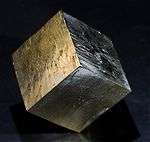 Cubic pyrite |
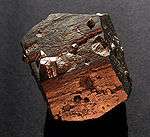 Pyritohedral |
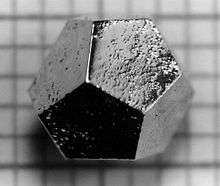 Ho-Mg-Zn quasicrystal |
Cartesian coordinates
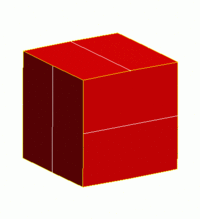
The coordinates of the eight vertices of the original cube are:
- (±1, ±1, ±1)
The coordinates of the 12 vertices of the cross-edges are:
- (0, ±(1 + h), ±(1 − h2))
- (±(1 + h), ±(1 − h2), 0)
- (±(1 − h2), 0, ±(1 + h))
where h is the height of the wedge-shaped "roof" above the faces of the cube. When h = 1, the six cross-edges degenerate to points and a rhombic dodecahedron is formed. When h = 0, the cross-edges are absorbed in the facets of the cube, and the pyritohedron reduces to a cube. When h = √5 − 1/2, the inverse of the golden ratio, the result is a regular dodecahedron.
A reflected pyritohedron is made by swapping the nonzero coordinates above. The two pyritohedra can be superimposed to give the compound of two dodecahedra as seen in the image here.
Geometric freedom
The pyritohedron has a geometric degree of freedom with limiting cases of a cubic convex hull at one limit of colinear edges, and a rhombic dodecahedron as the other limit as 6 edges are degenerated to length zero. The regular dodecahedron represents a special intermediate case where all edges and angles are equal.
| 1 : 1 | 1 : 1 | 2 : 1 | 1.3092... : 1 | 1 : 1 | 0 : 1 |
|---|---|---|---|---|---|
| h = −√5 + 1/2 | h = 0 | h = √5 − 1/2 | h = 1 | ||
 Regular star, great stellated dodecahedron, with pentagons distorted into regular pentagrams |
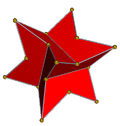 Concave pyritohedral dodecahedron is called a endo-dodecahedron and can tessellate space with the convex regular dodecahedron. |
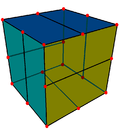 A cube can be divided into a pyritohedron by bisecting all the edges, and faces in alternate directions. |
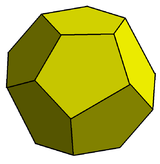 The geometric proportions of the pyritohedron in the Weaire–Phelan structure |
 A regular dodecahedron is an intermediate case with equal edge lengths. |
 A rhombic dodecahedron is the limiting case with the 6 crossedges reducing to length zero. |
Tetartoid
| Tetartoid Tetragonal pentagonal dodecahedron | |
|---|---|
 | |
| Face polygon | irregular pentagon |
| Conway notation | gT |
| Faces | 12 |
| Edges | 30 (6+12+12) |
| Vertices | 20 (4+4+12) |
| Symmetry group | T, [3,3]+, (332), order 12 |
| Properties | convex, face transitive |
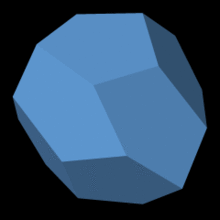
A tetartoid (also tetragonal pentagonal dodecahedron, pentagon-tritetrahedron, and tetrahedric pentagon dodecahedron) is a dodecahedron with chiral tetrahedral symmetry (T). Like the regular dodecahedron, it has twelve identical pentagonal faces, with three meeting in each of the 20 vertices. However, the pentagons are not regular and the figure has no fivefold symmetry axes.
Although regular dodecahedra do not exist in crystals, the tetartoid form does. The name tetartoid comes from the Greek root for one-fourth because it has one fourth of full octahedral symmetry, and half of pyritohedral symmetry.[1] The mineral cobaltite can have this symmetry form.[2]
| cobaltite |
|---|
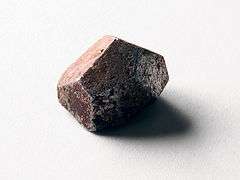 |
Its topology can be as a cube with square faces bisected into 2 rectangles like the pyritohedron, and then the bisection lines are slanted retaining 3-fold rotation at the 8 corners.
Cartesian coordinates
The following points are vertices of a tetartoid pentagon under tetrahedral symmetry:
- (a, b, c); (−a, −b, c); (−n/d1, −n/d1, n/d1); (−c, −a, b); (−n/d2, n/d2, n/d2),
under the following conditions:[3]
- 0 ≤ a ≤ b ≤ c,
- n = a2c − bc2,
- d1 = a2 − ab + b2 + ac − 2bc,
- d2 = a2 + ab + b2 − ac − 2bc,
- nd1d2 ≠ 0.
Variations
It can be seen as a tetrahedron, with edges divided into 3 segments, along with a center point of each triangular face. In Conway polyhedron notation it can be seen as gT, a gyro tetrahedron.
 |
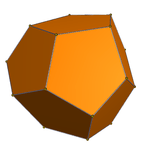 |
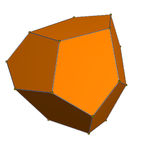 |
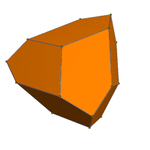 |
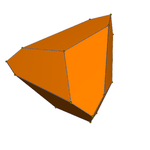 |
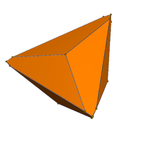 |
Rhombic dodecahedron

The rhombic dodecahedron is a zonohedron with twelve rhombic faces and octahedral symmetry. It is dual to the quasiregular cuboctahedron (an Archimedean solid) and occurs in nature as a crystal form. The rhombic dodecahedron packs together to fill space.
The rhombic dodecahedron can be seen as a degenerate pyritohedron where the 6 special edges have been reduced to zero length, reducing the pentagons into rhombic faces.
The rhombic dodecahedron has several stellations, the first of which is also a parallelohedral spacefiller.
Another important rhombic dodecahedron, the Bilinski dodecahedron, has twelve faces congruent to those of the rhombic triacontahedron, i.e. the diagonals are in the ratio of the golden ratio. It is also a zonohedron and was described by Bilinski in 1960.[4] This figure is another spacefiller, and can also occur in non-periodic spacefillings along with the rhombic triacontahedron, the rhombic icosahedron and rhombic hexahedra.[5]
Other dodecahedra
There are 6,384,634 topologically distinct convex dodecahedra, excluding mirror images, having at least 8 vertices.[6] (Two polyhedra are "topologically distinct" if they have intrinsically different arrangements of faces and vertices, such that it is impossible to distort one into the other simply by changing the lengths of edges or the angles between edges or faces.)
Topologically distinct dodecahedra (excluding pentagonal and rhombic forms)
- Uniform polyhedra:
- Decagonal prism – 10 squares, 2 decagons, D10h symmetry, order 40.
- Pentagonal antiprism – 10 equilateral triangles, 2 pentagons, D5d symmetry, order 20
- Johnson solids (regular faced):
- Pentagonal cupola – 5 triangles, 5 squares, 1 pentagon, 1 decagon, C5v symmetry, order 10
- Snub disphenoid – 12 triangles, D2d, order 8
- Elongated square dipyramid – 8 triangles and 4 squares, D4h symmetry, order 16
- Metabidiminished icosahedron – 10 triangles and 2 pentagons, C2v symmetry, order 4
- Congruent irregular faced: (face-transitive)
- Hexagonal bipyramid – 12 isosceles triangles, dual of hexagonal prism, D6h symmetry, order 24
- Hexagonal trapezohedron – 12 kites, dual of hexagonal antiprism, D6d symmetry, order 24
- Triakis tetrahedron – 12 isosceles triangles, dual of truncated tetrahedron, Td symmetry, order 24
- Other less regular faced:
- Hendecagonal pyramid – 11 isosceles triangles and 1 regular hendecagon, C11v, order 11
- Trapezo-rhombic dodecahedron – 6 rhombi, 6 trapezoids – dual of triangular orthobicupola, D3h symmetry, order 12
- Rhombo-hexagonal dodecahedron or elongated Dodecahedron – 8 rhombi and 4 equilateral hexagons, D4h symmetry, order 16
- Truncated pentagonal trapezohedron, D5d, order 20, topologically equivalent to regular dodecahedron
See also
- 120-cell: a regular polychoron (4D polytope) whose surface consists of 120 dodecahedral cells.
- Pentakis dodecahedron
- Snub dodecahedron
- Truncated dodecahedron
References
- ↑ Dutch, Steve. The 48 Special Crystal Forms. Natural and Applied Sciences, University of Wisconsin-Green Bay, U.S.
- ↑ Crystal Habit. Galleries.com. Retrieved on 2016-12-02.
- ↑ The Tetartoid. Demonstrations.wolfram.com. Retrieved on 2016-12-02.
- ↑ Hafner, I. and Zitko, T. Introduction to golden rhombic polyhedra. Faculty of Electrical Engineering, University of Ljubljana, Slovenia.
- ↑ Lord, E. A.; Ranganathan, S. and Kulkarni, U. D. (2000). "Tilings, coverings, clusters and quasicrystals". Curr. Sci. 78: 64–72.
- ↑ Counting polyhedra. Numericana.com (2001-12-31). Retrieved on 2016-12-02.
External links
| Wikimedia Commons has media related to Regular dodecahedra. |
- Plato's Fourth Solid and the "Pyritohedron", by Paul Stephenson, 1993, The Mathematical Gazette, Vol. 77, No. 479 (Jul., 1993), pp. 220–226
- THE GREEK ELEMENTS
- Stellation of Pyritohedron VRML models and animations of Pyritohedron and its stellations.
- Klitzing, Richard. "3D convex uniform polyhedra o3o5x – doe".
- Editable printable net of a dodecahedron with interactive 3D view
- The Uniform Polyhedra
- Origami Polyhedra – Models made with Modular Origami
- Dodecahedron – 3D model that works in your browser
- Virtual Reality Polyhedra The Encyclopedia of Polyhedra
- Dodecahedra variations
- VRML models
- Regular dodecahedron regular
- Rhombic dodecahedron quasiregular
- Decagonal prism vertex-transitive
- Pentagonal antiprism vertex-transitive
- Hexagonal dipyramid face-transitive
- Triakis tetrahedron face-transitive
- hexagonal trapezohedron face-transitive
- Pentagonal cupola regular faces
- K.J.M. MacLean, A Geometric Analysis of the Five Platonic Solids and Other Semi-Regular Polyhedra
- Dodecahedron 3D Visualization
- Stella: Polyhedron Navigator: Software used to create some of the images on this page.
- How to make a dodecahedron from a Styrofoam cube
| Fundamental convex regular and uniform polytopes in dimensions 2–10 | ||||||||||||
|---|---|---|---|---|---|---|---|---|---|---|---|---|
| Family | An | Bn | I2(p) / Dn | E6 / E7 / E8 / E9 / E10 / F4 / G2 | Hn | |||||||
| Regular polygon | Triangle | Square | p-gon | Hexagon | Pentagon | |||||||
| Uniform polyhedron | Tetrahedron | Octahedron • Cube | Demicube | Dodecahedron • Icosahedron | ||||||||
| Uniform 4-polytope | 5-cell | 16-cell • Tesseract | Demitesseract | 24-cell | 120-cell • 600-cell | |||||||
| Uniform 5-polytope | 5-simplex | 5-orthoplex • 5-cube | 5-demicube | |||||||||
| Uniform 6-polytope | 6-simplex | 6-orthoplex • 6-cube | 6-demicube | 122 • 221 | ||||||||
| Uniform 7-polytope | 7-simplex | 7-orthoplex • 7-cube | 7-demicube | 132 • 231 • 321 | ||||||||
| Uniform 8-polytope | 8-simplex | 8-orthoplex • 8-cube | 8-demicube | 142 • 241 • 421 | ||||||||
| Uniform 9-polytope | 9-simplex | 9-orthoplex • 9-cube | 9-demicube | |||||||||
| Uniform 10-polytope | 10-simplex | 10-orthoplex • 10-cube | 10-demicube | |||||||||
| Uniform n-polytope | n-simplex | n-orthoplex • n-cube | n-demicube | 1k2 • 2k1 • k21 | n-pentagonal polytope | |||||||
| Topics: Polytope families • Regular polytope • List of regular polytopes and compounds | ||||||||||||
